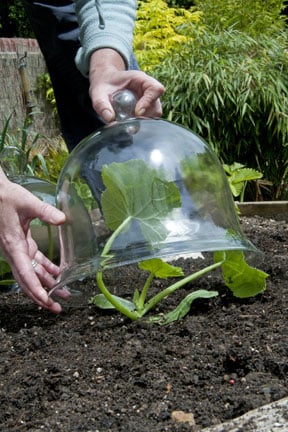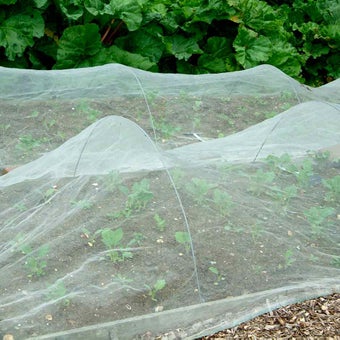
Quick facts
Insect-proof mesh is a non-chemical solution for many crops
It gives some shelter from the weather
It can last up to ten years
Rips and holes can be mended with epoxy resin glue and patches
Smaller invertebrates need finer mesh to exclude them
Why use insect-proof mesh?
The main purpose of insect-proof mesh is to keep insects such as white butterflies and flea beetle off crops. Creating a physical barrier can be effective and an alterative to using pesticides.
The mesh looks a little like net curtains but is made of clear polythene. Mesh sizes are significantly more open than horticultural fleece meaning it provides little extra warmth. However, it does give good wind, rain and hail protection.
Advantages
Protection against insects: Used as a physical barrier, insect proof meshes confer protection against plant eating insects often without significant increases in temperature (depending on mesh size) but with good protection against wind and hail. They also intercept heavy rain reducing the damage that large raindrops can do to soil structure, seed beds and seedlings. Soil splash that can contaminate leafy crops is also reduced.
Many problems including root feeding insects such as carrot fly and cabbage root fly are better managed by insect proof mesh than pesticides and the extra shelter leads to better plants and heavier crops.
Stretching mesh, even by placing over hoops, can widen the gaps and reduce efficacy. Check manufacturer’s instructions. The edges of the mesh are best buried under at least 5cms of soil.
Plants should not be cramped as they grow under mesh coverings and slack should be included when covering to allow for plant growth.
Although horticultural fleece can exclude invertebrates very effectively, it is much less durable and can be easily damaged when removed for weed control. Fleece can also raise temperatures and humidity to levels that might be undesirable.
Crop rotation should be practised, as some invertebrates can get through the mesh and might persist until the following year, ready to multiply when the same crop is planted and the mesh replaced.
Disadvantages
Limited capture of warmth: Fleece should be used where crops need to be provided with extra warmth or frost protection.
Encouraging diseases and slugs: Raised humidity levels and subsequent soft, lush growth produced when growing under insect proof mesh may encourage diseases such as Botrytis and downy mildew. Slugs and snails can be encouraged by the higher humidity beneath mesh.
Restricting access to weeds: Unfortunately it is usually necessary to uncover plants every two to three weeks to hoe, weed and also thin seed sown plants. This risks the insect species that cause damage gaining entry; once inside the mesh they are likely to multiply.
Egg laying through the mesh: Insects can sometimes lay eggs through the mesh if the mesh touches the crop foliage. Ensuring the mesh does not touch the plants reduces the likelihood of this occurring.
Pollination problems: Insect-pollinated crops such as strawberries and courgettes are unsuited to growing under insect-proof mesh during their flowering period.
Netting and wildlife: Wildlife can be at risk from poorly erected and managed garden netting. Very fine mesh, such as insect-proof mesh or horticultural fleece, is one of the safer options, but it is essential to secure the edges of the mesh by burying under the soil or anchoring to a ground level board half sunken in the soil. Birds in particular can become entangled in loose netting which may result in their death or injury.
Sustainability: Insect proof mesh may last five to ten years but unfortunately cannot be easily recycled. However, local recycling facilities should be checked. Insect netting made from biodegradable plant starch is now available from Andermatt, providing an eco-friendly option to gardeners.
Product choice
Insect-proof mesh is offered in pre-cut sizes, a variety of widths and any length can be ordered ‘off the roll’. The larger the sheet and the closer it is to manufactured sizes the less it costs per square metre.
Mesh is also sold in varying mesh sizes. The smaller the mesh the smaller the insect excluded but the greater the cost and also potential increase in temperature (finer meshed insect proof material may lead to a significant warming for the covered crops) and humidity beneath. On the other hand, finer meshes tend to be lighter and easier to use without supporting hoops.
Standard mesh: 1.3-1.4 mm. Good for insects such as cabbage root fly, onion fly, bean seed fly and carrot fly, as well as moth and butterflies. Birds and mammals can also be excluded. Although theoretically capable of penetrating mesh, mammals and larger birds seldom do, so there is rarely any need to add further protection such as bird netting. However, this size is unreliable in excluding small insects such as aphids,flea beetle, allium leaf miner and leek moth.
Fine mesh: 0.8 mm. Good for very small insects such as flea beetles, cabbage whitefly, moth and butterflies, leaf miners (including allium leaf miner), greenfly, blackfly, as well as cabbage root fly, onion fly, bean seed fly and carrot fly. Birds and mammals are also excluded.
Ultrafine mesh: 0.3-0.6 mm. This size gives good protection against thrips, flea beetles and other very small invertebrates. Birds and mammals are also excluded.
Butterfly netting: Fine nets with a 4-7 mm mesh give good protection against white butterflies as long as the foliage does not touch the net, and of course bird and mammals.


